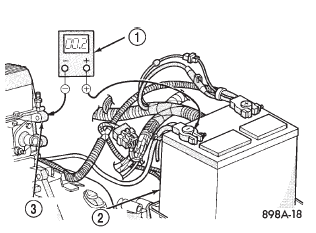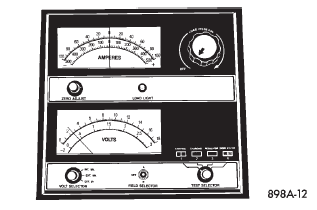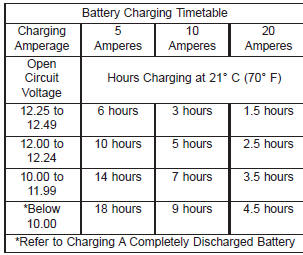Service procedures
Battery charging
Battery charging is the means by which the battery can be restored to its full voltage potential. A battery is fully-charged when:
- All of the battery cells are gassing freely during battery charging.
- A green color is visible in the sight glass of the battery built-in test indicator.
 Fig. 16 Test Ground Circuit Resistance - Typical
Fig. 16 Test Ground Circuit Resistance - Typical
1 - VOLTMETER
2 - BATTERY
3 - ENGINE GROUND
- Three hydrometer tests, taken at one-hour intervals, indicate no increase in the temperature-corrected specific gravity of the battery electrolyte.
- Open-circuit voltage of the battery is 12.4 volts or above.
WARNING:
- IF THE BATTERY SHOWS SIGNS OF FREEZING, LEAKING, LOOSE POSTS, OR LOW ELECTROLYTE LEVEL, DO NOT TEST, ASSIST-BOOST, OR CHARGE. THE BATTERY MAY ARC INTERNALLY AND EXPLODE. PERSONAL INJURY AND/OR VEHICLE DAMAGE MAY RESULT.
- EXPLOSIVE HYDROGEN GAS FORMS IN AND
AROUND THE BATTERY. DO NOT SMOKE, USE
FLAME, OR CREATE SPARKS NEAR THE BATTERY.
PERSONAL INJURY AND/OR VEHICLE DAMAGE MAY RESULT.
- THE BATTERY CONTAINS SULFURIC ACID, WHICH IS POISONOUS AND CAUSTIC. AVOID CONTACT WITH THE SKIN, EYES, OR CLOTHING. IN THE EVENT OF CONTACT, FLUSH WITH WATER AND CALL A PHYSICIAN IMMEDIATELY. KEEP OUT OF THE REACH OF CHILDREN.
- IF THE BATTERY IS EQUIPPED WITH REMOVABLE CELL CAPS, BE CERTAIN THAT EACH OF THE CELL CAPS IS IN PLACE AND TIGHT BEFORE THE BATTERY IS RETURNED TO SERVICE. PERSONAL INJURY AND/OR VEHICLE DAMAGE MAY RESULT FROM LOOSE OR MISSING CELL CAPS.
CAUTION:
- Always disconnect and isolate the battery negative cable before charging a battery. Do not exceed sixteen volts while charging a battery. Damage to the vehicle electrical system components may result.
- Battery electrolyte will bubble inside the battery
case during normal battery charging. Electrolyte
boiling or being discharged from the battery
vents indicates a battery overcharging condition.
Immediately reduce the charging rate or turn off the charger to evaluate the battery condition. Damage to the battery may result from overcharging.
- The battery should not be hot to the touch. If the battery feels hot to the touch, turn off the charger and let the battery cool before continuing the charging operation. Damage to the battery may result.
Some battery chargers are equipped with polaritysensing circuitry. This circuitry protects the battery charger and the battery from being damaged if they are improperly connected. If the battery state-ofcharge is too low for the polarity-sensing circuitry to detect, the battery charger will not operate. This makes it appear that the battery will not accept charging current. See the instructions provided by the manufacturer of the battery charger for details on how to bypass the polarity-sensing circuitry.
After the battery has been charged to 12.4 volts or greater, perform a load test to determine the battery cranking capacity. Refer to Battery in the index of this service manual for the location of the battery diagnosis and testing procedures for more information on the proper battery load testing procedures. If the battery will endure a load test, return the battery to service. If the battery will not endure a load test, it is faulty and must be replaced.
Clean and inspect the battery hold downs, tray, terminals, posts, and top before completing battery service. Refer to Battery in the index of this service manual for the location of the proper battery cleaning and inspection procedures.
CHARGING A COMPLETELY DISCHARGED BATTERY
The following procedure should be used to recharge a completely discharged battery. Unless this procedure is properly followed, a good battery may be needlessly replaced.
(1) Measure the voltage at the battery posts with a voltmeter, accurate to 1/10 (0.10) volt (Fig. 17). If the reading is below ten volts, the battery charging current will be low. It could take some time before the battery accepts a current greater than a few milliamperes.
Such low current may not be detectable on the ammeters built into many battery chargers.
 Fig. 17 Voltmeter Accurate to 1/10 Volt Connected - Typical
Fig. 17 Voltmeter Accurate to 1/10 Volt Connected - Typical
(2) Disconnect and isolate the battery negative cable. Connect the battery charger leads. Some battery chargers are equipped with polarity-sensing circuitry.
This circuitry protects the battery charger and the battery from being damaged if they are improperly connected. If the battery state-of-charge is too low for the polarity-sensing circuitry to detect, the battery charger will not operate. This makes it appear that the battery will not accept charging current.
See the instructions provided by the manufacturer of the battery charger for details on how to bypass the polarity-sensing circuitry.
(3) Battery chargers vary in the amount of voltage
and current they provide. The amount of time
required for a battery to accept measurable charging
current at various voltages is shown in the Charge
Rate chart. If the charging current is still not measurable
at the end of the charging time, the battery
is faulty and must be replaced. If the charging current
is measurable during the charging time, the battery
may be good and the charging should be
completed in the normal manner. 
CHARGING TIME REQUIRED
The time required to charge a battery will vary, depending upon the following factors:
- Battery Capacity
A completely discharged heavy-duty battery requires twice the charging time of a small capacity battery.
- Temperature
A longer time will be needed to charge a battery at -18 C (0 F) than at 27 C (80 F). When a fast battery charger is connected to a cold battery, the current accepted by the battery will be very low at first.
As the battery warms, it will accept a higher charging current rate (amperage).
- Charger Capacity
A battery charger that supplies only five amperes will require a longer charging time. A battery charger that supplies twenty amperes or more will require a shorter charging time.
- State-Of-Charge
A completely discharged battery requires more charging time than a partially discharged battery. Electrolyte is nearly pure water in a completely discharged battery. At first, the charging current (amperage) will be low. As the battery charges, the specific gravity of the electrolyte will gradually rise.
WARNING: NEVER EXCEED TWENTY AMPERES WHEN CHARGING A COLD (-1 C or 30 F) BATTERY.
THE BATTERY MAY ARC INTERNALLY AND
EXPLODE. PERSONAL INJURY AND/OR VEHICLE
DAMAGE MAY RESULT. 
Dodge Durango (DN) 1998-2003 Service Manual
- Lubrication and Maintenance
- Suspension
- Differential and Driveline
- Brakes
- Cooling System
- Battery
- Starting Systems
- Charging System
- Ignition System
- Instrument Panel Systems
- Audio Systems
- Horn Systems
- Speed Control System
- Turn Signal and Hazard Warning Systems
- Wiper and Washer Systems
- Lamps
- Passive Restraint Systems
- Electrically Heated Systems
- Power Distribution System
- Power Lock Systems
- Vehicle Theft/Security Systems
- Power Seat System
- Power Window Systems
- Power Mirror Systems
- Chime/Buzzer Warning Systems
- Overhead Console Systems
- Engine
- Exhaust System
- Frame and Bumpers
- Fuel System
- Steering
- Transmission and Transfer Case
- Tires and Wheels
- Body
- Heating and Air Conditioning
- Emission Control Systems
- Introduction
